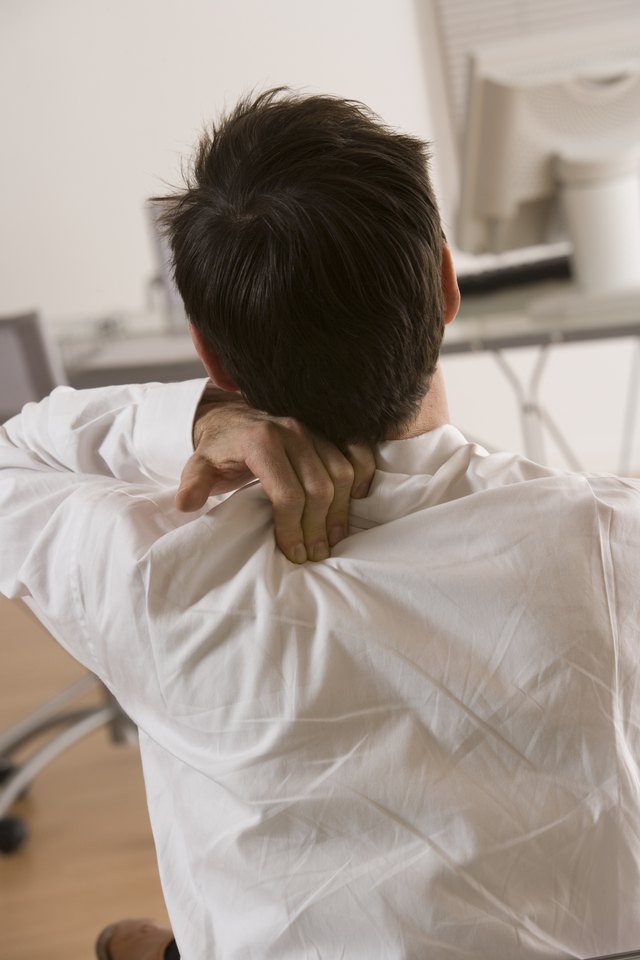A Trapezius Pushup

The trapezius muscle covers the shoulders, upper back and neck. Every time you shrug your shoulders or reach over your head, you activate the upper trapezius muscle. Stress and repetitions of these movements often cause the lower trapezius muscle to become overextended and weak. Balanced trapezius muscles relieve tension and alleviate pain in the shoulders and neck. You may try different types of push-ups to work the upper and lower trapezius muscles to keep them strong.
Pike Shoulder Press
The pike shoulder press, sometimes called a press up, is designed to work the upper trapezius muscle. The main difference between the position of a pike shoulder press and a traditional push-up is that the hips are elevated high in the air. The higher the incline, the greater the stress placed on the upper trapezius. Get on all fours and start by standing on your toe tips. This will place your hips in their highest position while your hands are flat on the floor. Pull your navel in toward your spine and keep your arms extended. Inhale as you bend your elbows and lower your upper body and head toward the ground. Contract your muscles and exhale as you push up to your starting position.
Chair Push-up
Chair push-ups build the lower trapezius muscle. Doing a chair push-up is relatively straight forward. Just sit at the edge of a chair with your hands at your sides. Place your palms down on the chair and curl your fingers around the seat edge. Keep your elbows extended and lift your hips up off the seat for a complete push-up. If you are more comfortable keeping your feet flat on the floor, it is okay because it will not detract from the focus of the exercise. Never hold your breath during the trapezius push-up. Keep the shoulders back, down and depressed in the elevated position before lowering yourself slowly back down.
Stability Ball Push-up
Stability ball push-ups are similar to chair push-ups in that they also strengthen the lower trapezius muscle. However, the body assumes a more unnatural position during execution. Users stabilize their bodies on the tips of the toes at the center of the stability ball. This automatically places the entire body on a decline and uses the force of gravity to put weight on the upper body. Contract your back and abdominal muscles to maintain balance. Keep your palms flat on the ground and push up until your arms are completely extended. This should almost level your bottom with the heels of your feet.
Caveats
With proper form the pike shoulder press, chair push-up and stability ball push-up are easily performed without danger. Of course you want to be sure that any chair, ball or object employed is primarily stable to prevent slips and falls. Do not begin any exercise, however, in an attempt to alleviate trapezius pain without consulting a medical professional first. If you get headaches, deep aches over the top of your shoulders, jaw pain, dizziness or severe neck pain, a clinician may have to rule out misaligned vertebrae, occipital neuralgia or a cervicogenic disorder.
References
- YouTube: Pike Shoulder Press : Best Shoulder Exercises
- Sports Injury Clinic: Seated Push Up Shoulder Exercise
- Science Daily: Strengthening the Lower Trapezius Muscle: Thera-Band Exercise & Chair Push Ups
- Physical Fitnet LLC: Decline Pushup With Feet On Stability Ball
- Valerie DeLaune, LAc: Pain Relief with Trigger Point Self-Help: Trapezius Sections:
Writer Bio
Sarah McLeod began writing professionally for the federal government In 1999. In 2002 she was trained by Georgetown University's Oncology Chief to abstract medical records and has since contributed to Phase I through Phase IV research around the country. McLeod holds a Bachelor of Arts in human services from George Washington University and a Master of Science in health science from Touro University.
